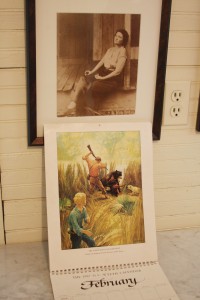She often started her day on the front porch. A small manual typewriter awaited her words. But I like to imagine Marjorie Kinnan Rawlings ignored the typewriter at first. I picture her comfortable in her chair at the big round wood table, coffee mug in hand, easing into the morning routine one sip at a time.
Marjorie inhaled the fragrance of orange blossoms right outside her front door and worried how she was going to afford living in her piece of paradise.
And worry she did. We forget that part. At the beginning of her Cross Creek years Rawlings was not rich and famous. She had not yet written “Cross Creek” or won the 1939 Pulitzer Prize for “The Yearling” – a book written on this very porch.
She came to Cross Creek with her husband Charles Rawlings in 1928 hoping to make a home and have a place to write. The dream faded. They divorced in 1933. Charles moved on, leaving behind his hunting dog, a black and white spotted hound named Mo. I picture Mo on the porch with Marjorie, tail thumping the wooden boards when she reached down to scratch him behind the ears.
Marjorie Kinnan Rawlings found her home in Cross Creek
Marjorie stayed at Cross Creek after the divorce. How could she not? Here is what she said in 1928 when she first arrived:
” When I came to the Creek, I knew the old grove and the farmhouse at once as home.”
Like many women suddenly left to their own devices through divorce or death Marjorie got creative in a hurry. This was not an easy assignment in the Great Depression years. She and her help raised chickens and planted a vegetable garden. There were orange trees on the property. She doubled their number. For a few years oranges provided the main income.
Writing was secondary. One of her early novels was serialized in a magazine – one chapter a month. Pecking away at the typewriter on the porch, she sent chapter by chapter off in the mail then anxiously awaited her checks.
Inside her home, now a National Historic Landmark, one room is set aside to showcase her books. On a top shelf are copies of “The Yearling” translated into different languages. Park Ranger Sheila Barnes tells me Rawlings was fortunate to write at a time when reading ruled. Television and computers didn’t exist. Readers devoured books, especially novels and writers made a living.
For the second edition of “The Yearling” famed illustrator N.C. Wyeth came and stayed three weeks at Cross Creek. It was his first visit to Florida, the first time he ever painted Spanish moss on a tree or captured the quality of late afternoon sunlight on Orange Lake. His illustrations are displayed in a calendar in the reading room.
When I visited recently Barnes came walking towards the gate wearing a period dress from the 1930s. Trotting alongside her was a dog that looked a lot like the old photographs of Mo standing next to Rawlings.
This dog is Sugar, a spotted hound rescued from a shelter. Since park personnel interpret the seasonal life at Cross Creek, it was determined a dog could be added to staff interpretation if it got along well with people and fit the description of dogs owned by Rawlings. Sugar fills the bill beautifully.
Rawlings died in 1953. Her Cross Creek homestead is southwest of Gainesville on County Road 325 and it is a state park.
Marjorie Kinnan Rawlings Historic State Park is described in its brochure as an “inspirational literary landmark”. A large plaque informs visitors that the house and farmyard were designated a National Historic Landmark in 2006. And in 2008 Marjorie even got her own U.S. Postal Service stamp as part of honoring the literary arts.
Marjorie Kinnan Rawlings wrote her books while sitting on the porch
When I visit this piece of Old Florida I always feel I’ve stepped onto sacred ground, sacred for a writer anyway, especially the porch. I look at the little typewriter, the vase of fresh flowers nearby, a large glass ashtray next to the typewriter and it seems so immediate. Perhaps Marjorie will be back any minute, sit down at the typewriter and tap away.
The staff clearly loves this place, keeping the kitchen in working order and planting the garden with seasonal vegetables. Both Barnes and Park Manager Valerie Rivers dress in period costume. Staff plus a dedicated group of volunteers contribute to the sense that the past is present.
Visitors can become enchanted easily. You can almost hear Rawlings saying these words:
“I do not understand how any one can live without some small place of enhancement to turn to.”
Enchantment is a marvelous word. Cross Creek was Marjorie’s enchantment.
At the end of the day Rawlings came to understand something quite profound – that we are all caretakers, not owners, of this earth we call home. She closes her book “Cross Creek” with these words:
“It seems to me that the earth may be borrowed but not bought. It may be used but not owned. It gives itself in response to love and tending, offers its seasonal flowering and fruiting. But we are tenants and not possessors, lovers and not masters. Cross Creek belongs to the wind and the rain, to the sun and the seasons, to the secrecy of seed, and beyond all, to time.”
©2008 Lucy Beebe Tobias. All rights reserved. For reprint information, contact [email protected]
Lucy Beebe Tobias is the Authentic Florida Expert for VISIT FLORIDA and the author of “50 Great Walks in Florida.”
WHEN YOU GO
What: Marjorie Kinnan Rawlings Historic State Park, 18700 S. County Road 325, Cross Creek, Fl. 32640, phone: (352) 466-3672
Hours: Farmyard and trails open 9-5 every day.
Park Admission Fee: $2 per vehicle
House Tour: A tour inside the house from October through July on Thursday through Sunday at 10 a.m. and 11 a.m. and each hour from 1 p.m. to 4 p.m.
Tour Fee: $3 per adult, $2 children 6-12, under the age of six are free
Next door: M.K Rawlings County Park with boat ramp access to Orange Lake


